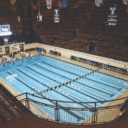Behind the Venue: The Kiphuth Exhibition Pool, 89 years on
Yale swimmers and divers first graced its waters in 1932. In the eight decades since, the Exhibition Pool has nurtured Olympians, hosted performances and helped to shape the sport of swimming.

Anasthasia Shilov, Illustrations Editor and Zully Arias, Production and Design Editor
“Behind the Venue” is a series of feature-form articles that dives into the history, character and most memorable moments of Yale’s various athletic forums — from stadiums and fields to pools and boathouses. While not all articles in the series will resemble one another, all attempt to take a deeper look into how these places came to be and how they have fared over time. This is the fourth article in the series.
The Robert J. H. Kiphuth Exhibition Pool is an impressive space. 2,187 seats rise from the floor at a 45 degree angle up to the ceiling, forming a cavernous 50-foot high funnel around the small, six-lane, 25-yard pool. Crests from the Ancient Eight hang suspended high above the glistening water, flanked by four NCAA championship banners captured by Eli swimmers decades ago.
Yale’s swimming and diving teams have called the space home since 1932, breaking world records and contributing to the development of the sport as swimmers know it today. The Exhibition Pool has played host to the NCAA and AAU championships, bringing swimming and diving’s best to New Haven.
Matt Meade ’87, president of the Yale Swimming and Diving Association, recalled the electric atmosphere during competition.
“There was something electric when the team would emerge on the pool deck from the office near the starting blocks — the energy was incredible and inspired a lot of us to some great races and personal triumphs in the pool,” Meade said.
But decades of laps, races, dual-meets and water polo matches have taken its toll on the historic venue. No longer is the Exhibition Pool a shining jewel in American swimming, with its six lanes and straight-edge walls showing signs of obsolescence in a sport that has experienced rapid technological advances.
Coach Robert Kiphuth and the Exhibition Pool’s early history
Early Eli teams practiced at Carnegie Pool, formerly located where Trumbull College stands today. Constructed from a $40,000 dollar donation from Andrew Carnegie in 1907, the structure had a seating capacity of 500. But just two decades later, Carnegie was deemed to be too small for the growing Yale team, and in 1932 the program moved into its current location in the newly-opened Payne Whitney Gymnasium.
The new aquatic facility was officially opened in a ceremony on Nov. 28, when Captain A. T. Hapke, Jr. ‘33 poured a bottle of water from Carnegie into the new swimming pool. Twelve days later, the Exhibition Pool hosted its first meet: Yale Bulldogs vs. Yale Alumni. A crowd of 1,500 gathered in the aquatic colosseum to witness the alumni defeat the Bulldogs in both water polo and swimming.
The swim team’s loss that day marked its first defeat in 117 meets — an early tally set by coach Robert Kiphuth who went on to break that, and many more records, during his 41-year long tenure.
Some of the best swimmers from around the world travelled to New Haven each year, recognizing the Exhibition Pool as the center of the swimming world and Kiphuth, who also coached the U.S. Olympic Swim Team, as its messiah.
During a visit in 1933, Olympic backstroker Joan McSheehy told the News “the pool is rivalled only by the good looking men of Eli.”
McSheehy’s teammate, Constance Hanf, shared a similar sentiment, believing that “Yale ought to win with a pool like that.”
And win they did. With the Exhibition Pool as their home base, Kiphuth led the Elis to four NCAA titles between 1942 and 1953, recording 528 wins and only 12 losses. Through his stewardship as head coach, Yale alumni regularly made the Olympic Games, with four medalling at the 1964 Tokyo games.
In 1967, Kiphuth died of heart failure at the age of 76. Administrators quickly renamed the venue in his honor, forever attaching his name to the legacy he built in the Exhibition Pool.
While New Haven’s status as a swimming mecca is all but a distant memory, the Exhibition Pool’s decades of history and countless Olympians raised in its waters have inspired generations of Yale swimmers.
“We knew about all the amazing swimmers and divers who came before us,” Yale women’s swimming alumna Kristin Krebs-Dick ’93 said. “We knew its storied history and felt closely connected to it — like we owned it too and that made a difference in meets.”
Pageantry and flair: “Water Carnivals” and aquatic plays
The Exhibition Pool is not only a sign of Yale’s athletic prowess, however. At different points in its history, it has transformed from a temple of aquatic sports to a stage for some of Broadway’s finest.
The pool had a starring role in television in 1955; its high sloping seats providing a perfect backdrop for celebrity swimmer and actress Esther Williams in an episode of Alistair Cooke’s “Omnibus”.
For production, a section of the pool wall was demolished and fitted with a special underwater window to allow television cameras to film from an underwater vantage point. Not only was it used for the filming of Williams, but also for capturing footage of a dog, trout, frog and an Eli in a comparison and analysis of swimming styles.
Coach Kiphuth featured alongside Williams in the 35 minute episode, walking audiences through the history and development of swimming.
Kiphuth’s love and dedication for the sport gave birth to “Water Carnivals” — a celebration of aquatic sports — hosted annually in the space, bringing members of the community and all around the world together in the Exhibition Pool.
Former swimmer and water polo player Ted Jones ’64 recalls “a huge, full capacity crowd, a demonstration of water ballet, some kids races, exhibitions by varsity swimmers, record-time attempts and a comedy act by two guys who were recent NCAA champions.”
The 39th edition, held in 1961, featured exhibition races by female swimmers Chris Von Saltza and Lynne Burke, who captured a combined total of five gold medals at the 1960 Olympics in Rome.
Such was the importance of the carnival to the swimming world that a headline in a 1964 issue of the New York Times noted, “Yale’s Sellout Water Carnival Likely to Set a Record or Two”.
But athletics were not all that the pool was used for. In 1974, the Exhibition Pool was transformed by Burt Shevelove DRA ’40 and the Yale Repertory Theater into an unlikely stage for a production of “The Frogs” — an adaptation of an Ancient Greek comedy of the same name.
“[The Exhibition Pool is] the nearest thing we have in America to a greek amphitheater,” Shevelove told the New York Times in 1974.
An audience of 1,600 witnessed the aquatic play from the well of bleachers high up around the pool. Interspersed within them were members of the Yale Band, playing music by Steven Sondheim.
A cast of 68, buoyed by members of the swim team dressed in green speedos, flipped through the water, bringing the River Styx to life. Among the 21-person strong Greek chorus was a young Meryl Streep DRA ’75, Sigourney Weaver DRA ’74 and Christopher Durang DRA ’74.
“It was a very steamy production,” Weaver said to the Wall Street Journal in 2004. “It was one thing to put on a show, and then it was another to put on a show in a swimming pool.”
Relic from the past
In comparison to the state-of-the-art facilities now used by many in the Ancient Eight, some say Yale’s pool is comparably outdated and far behind the rest of the pack.
Harvard’s Blodgett Pool, for example, comprises two 25-yard courses — one with eight lanes and the other with six. The Ivy League’s newest natatorium, Brown’s Katherine Moran Coleman Aquatics center, features two moveable bulkheads that can separate the 56 meter long pool into three different sections.
The Exhibition Pool, on the other hand, has only six lanes, cannot be converted into a long-course length and lacks space for warm-up and cool-down during competition. Such drawbacks have made it ineligible for hosting NCAA meets and Ivy League championships, which require pools to be at least 50 meters long and eight lanes wide. As a result, it is only able to host head-to-head meets.
For former men’s captain Alex Righi ’09, the pool’s outdated features meant tinkering with his usual technique in order to gain an edge over his opponent during home meets.
He realized that the pool’s lack of turn-wall gutters created a wave following a swimmer that bounced back after a flip turn, potentially slowing the swimmer down on their next lap. Additionally, high walls meant that timing pads were awkwardly positioned, frequently resulting in a swimmer’s feet slipping during a start or turn.
Despite the pool’s flaws, Yale swimmers past and present are appreciative of the space they compete in.
“[The locker rooms] are relics of earlier eras, and although updated to some extent to accommodate modern-day demands (e.g., now there are locks on the door and the lockers themselves are newer), [they] are largely unchanged from when Yale swimming Olympians used them more than half a century ago,” Righi said. “That was frustrating at times for obvious reasons, but it also contributed to the sense of history and tradition permeating the facility and made me appreciate all of the legendary swimmers who’d come before.”
For others, the pool’s unique shape and character set it apart from all the rest.
When men’s captain Patrick Frith ’21 first visited, the first thought that came to mind was “wow, this is a lot smaller than my pool at home.”
“That somewhat apprehensive thought was immediately replaced by, ‘this might be the coolest pool I’ve ever seen,’” Frith said. “The view never gets old, the confines of the deck and high walls make every race feel like an Olympic final and the crowd noise bouncing off the walls of wooden seats is unlike any other venue in the country. There is no place I’d rather race.”
Diver Christian DeVol ’21 first visited the Exhibition Pool when he was 17, and was “encapsulated by the history and grandness,” immediately knowing it was where he wanted to dive.
Still, he “can’t wait for the day [the team] gets a new pool comparable to [its] Ivy League competitors.”
The Robert J. H. Kiphuth Exhibition Pool is the oldest competition pool in the Ivy League.
Ryan Chiao | ryan.chiao@yale.edu








